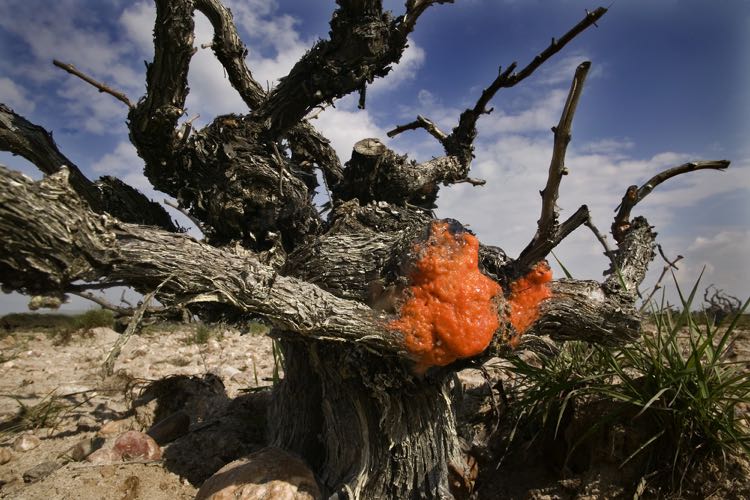From €7.40, £51.60 per case of 6, $9.99, £10.95, 1,919 yen, 1,714 roubles
Made from 100% Verdejo grapes, this fresh, zesty, lemon- and grapefruit-scented white wine is a delicious and great-value introduction to the Verdejo-obsessed wines of Ossian, a company founded in Segovia in Castilla y Léon in 2005 by Javier Zaccagnini and Ismael Gozalo with the aim of focusing exclusively on this variety, which Jancis describes in the Rueda entry of the Oxford Companion to Wine as ‘Rueda’s sleeping beauty’.
The heart of the Ossian project is their ungrafted pre-phylloxera Verdejo vineyard in the village of Nieva in the province of Segovia, north west of Madrid. The 100- to 200-year-old bush vines (pictured above and below) have probably survived phylloxera because the soils, while varied, are generally sandy. Even this wine, the least expensive of the Ossian range, is made 60% from this venerable vineyard, the other 40% from younger, trellised vines. The dramatic image below shows a close-up of one of the old vines with what they refer to as 'orange bleeding', produced by an apparently harmless group of fungi at the site of a pruning wound (explained in much more scientific detail in this article by Wendy McFadden-Smith of the Ontario ministry of agriculture).

The Ruiz Aragoneses family, owners of Pago de Carraovejas in nearby Ribera del Duero to the north east, took an interest in the Ossian project in 2013 and bought the company in 2016, with every intention of continuing to carry the torch for Verdejo and this treasure of a vineyard, which was the first to be certified organic in the Rueda DO, in 2001. Ossian also boasts the first organic-certified winery in the DO. The new investment will allow them to further develop research into the soils and climate as well as the microbiology of the soil.
Quintaluna, meaning ‘five moons’, alludes to the significance of the moon in the timing of tasks in the vineyard and winery, even though they have not so far sought biodynamic certification and do not follow all biodynamic practices.
All the grapes are hand-picked, sorted in the vineyard and chilled for a few hours before destemming and pressing. While the wine labelled simply Ossian and their top wine Capitel are partly fermented and aged in oak of various ages and sizes, Quintaluna is fermented in stainless-steel tanks. Fermentation is carried out at a relatively warm (for white wine) 19 ºC/66 ºF by ambient yeast rather than by commercially cultured strains. The wine spends several months on the yeast lees, which are stirred from time to time, and this gives the wine an extra layer of complexity – a richer and slightly creamy texture that is a counterpoint to the freshness of the fruit flavours and crisp acidity. For a wine at this price, it is impressively persistent.
While I could address readers in the northern hemisphere and say this makes a great summer wine, that would be to sell it short. It is delicious and worth lingering over, whatever the season, and would make a particularly good aperitif.
This was my tasting note: Lovely ripe lemon aroma with a fresher grapefruit note as well and just a slight stony quality adding another dimension to the fruit. Beautifully fragrant without being excessively perfumed, open and expressive, with a riper citrus – almost apricot – flavour on the palate. Succulent and full in the mouth though it is beautifully fresh. A wine that is both elegant and fruity and very good value.

Quintaluna and all the Ossian wines are imported into the UK by Justerini & Brooks, who sell them mainly in the on trade (restaurants, wine bars etc). Quintaluna is stocked by Bedales, Bacchus Fine Wines and City Wine Collection. When I asked Ossian for a list of distributors around the world, they kindly sent an enormous spreadsheet indicating that it is very widely available, as you will see if you use the link below to wine-searcher.com. Their list of export markets includes Belgium, Brazil, Bulgaria, China, Cuba, Canada and many more, not to mention the US, Singapore, Switzerland and Serbia.














